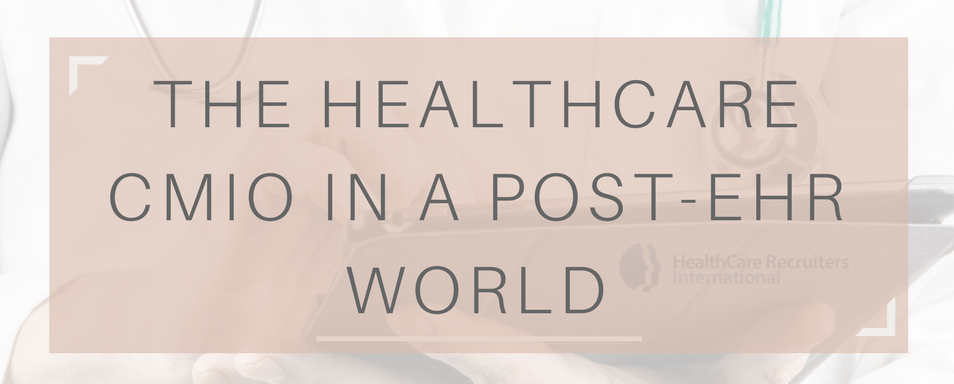With IT spending by hospitals expected to sharply increase towards levels seen industries like banking and reality, the healthcare industry is on the brink of potentially major change. Hospitals and healthcare organizations are preparing for a data-rich, real-time era of interconnected e-health.

Today, nearly three quarters of hospitals and health systems have a senior IT leader (such as a Chief Medical Information/Informatics Officer) to help guide the organization through complex and changing technology requirements. However, the CMIO role continues to evolve and will need to adapt as IT requirements are constantly changing. Initially, CMIOs were brought in to help implement EHR, but today their role is changing to include managing a wider range of IT initiatives, including cybersecurity, patient outcomes, population health management, process improvement, and compliance, according to Healthcare Dive.
Looking for a new Healthcare IT hire?
Contact our recruiters today!
Bringing Tools of Technology and Great Opportunities Together
The goal of the modern CMIO is to find ways to use technology to improve patient care. While healthcare informatics is more capable than ever to deliver long-awaited and sought after tools needed to improve the quality, safety and efficiency of patient care and healthcare processes, it’s hard to accomplish everything all at once. This is partly due to rapidly changing regulatory and business models that create a tsunami of demands that require meticulous prioritization and collaboration to tackle successfully.
Managing IT demands “takes a lot of collaboration with senior leadership and key stakeholders to get everybody on the same page,” said Colin Banas, CMIO at VCU Medical Center in Richmond VA, in a Healthcare Dive interview. To define and create tools that can be successfully implemented and used in a meaningful way, a core forward-thinking clinical informatics-focused leader is key.
Is your organization prepared for the future?
Contact us if you’re in need of new talent.
CMIO 2.0s Will Be Using IT as a Lever for Change
CMIO 2.0s must facilitate robust investment in the kind of infrastructure that can reveal opportunities through data that hospitals and health systems can leverage. While EHRs still make up a lot of the CMIO role, CMIOs must also “optimize existing users and meet new clinical and regulatory demands,” according to Healthcare Dive. Implementing EHR should be looked at as the foundation of the demands we see emerging today. Healthcare leaders are looking for ways to simultaneously reduce costs and physician burnout while increasing quality.
The fundamental shift in leadership skills for the CMIO 2.0, according to Amati Health, is that they must be able to engage others to get critical work done. They must be a strategic facilitator that activates conversation, between and among people they may not actually have authority over. CMIO 1.0 had a role where they were more directed on what to do and weren’t asked for strategic thinking as often as they are now. However, the role and demand is expanding, so CMIOs now need to drive clinical IT strategy. One of the biggest challenges is finding a way to successfully evolve from a role focused on implementing a clinical IT platform to becoming the main driver of both the IT platform and the strategy to accelerate its rollout. The next step is leveraging the technology to achieve improved clinical outcomes that the health system is trying to achieve.
CMIOs in the post-EHR Era
Historically speaking, IT has often been viewed as an unnecessary cost rather than something that can actually reduce costs while driving business initiatives. Hospital administrators can better support CMIOs by viewing IT as an opportunity to drive improvements, rather than a burden. Many health systems have implemented the EHR as their core clinical platform and have begun to move past stabilization, through a few cycles of workflow optimization and are now right in the midst of volume-based to value-based care transformation. CMIOs will need to shift right alongside the transformation.
Healthcare regulation, defining success as a healthcare organization and effectively engaging physicians in workflow optimization cycles will drive the roadmap going forward. CMIOs will need to continuously engage physicians in the optimization process, which requires workflow mapping, conducting usability testing, getting buy-in and then re-implementing. As we’ve reinforced throughout this article, the key to success for the CMIO 2.0 is having the ability to collaborate with many different people, both inside and outside the organization. The CMIO needs to get out there and not stay isolated if they hope to be successful as direct decisions makers and champions of some of the newer technologies around EHR. In the end, the ultimate goal is to create a platform that engages both patients and providers while delivering the best care possible.
Finding the Next CMIO for Your Organization
Candidates for executive-level positions in the field of Healthcare IT continue to be in high demand, but it’s not easy to differentiate yourself or find quality candidates without help. These candidates are sought after by major health providers, HMOs, hospitals, national chain pharmacies, universities and government health agencies.
The CMIO role is a high-profile positions that is more easily filled with the help of a specialized executive recruiting techniques and a team of dedicated healthcare IT recruiters. The recruiting experts at HCRI can help you overcome the burden of finding candidates to fill top-tier, hard-to-fill executive-level vacancies. If you’re in need of a new executive or C-level healthcare hire, contact us today.
Ready to find your next CMIO?
Don’t risk hiring the wrong talent!
Sources:
http://www.healthcareitnews.com/news/5-keys-evolving-role-cmio
